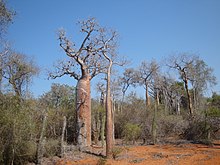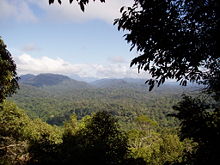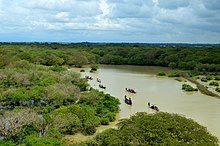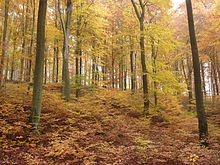Forest
![]()
The title of this article is ambiguous. For other meanings, see Forest (disambiguation).
![]()
Waldung is a redirect to this article. For the physician and professor of physics see Wolfgang Waldung.
Forest (Waldung) in the everyday language sense and in the sense of most technical languages is a section of the earth's surface that is covered with trees and exceeds a certain minimum cover and minimum size, depending on the context of interpretation.
The definition of forest is necessarily vague and depends on the context of meaning (everyday language, geographical, biological, legal, economic, cultural, ...). More precise definitions cover only a part of the context of meaning. A widespread definition in German forestry defines a forest as a plant formation that is "essentially composed of trees and covers such a large area that a characteristic forest climate can develop on it". According to § 2 of the German Federal Forest Act, a forest is "... any land area covered with forest plants. Clear-cut or thinned ground areas, forest roads and clearings are also considered forests".

Tropical dry forest, Madagascar

Tropical rainforest, Malaysia

Tropical monsoon swamp forest, Bangladesh
.jpg)
Mixed deciduous and coniferous forest, Quebec

Boreal coniferous forest, Finland

Subtropical laurel forest onLa Palma, Canary Islands

Summergreen deciduous forest in autumn foliage near Hülshof, Central Hesse
Word origin and terminology
The word Wald (from Middle High German/ Old High German walt) is based on a reconstructed Urgaritic *walþu 'tuft', in this case 'foliage', 'branches', which in turn may have originated from Indo-Germanic *wolɘt 'densely overgrown'. A relationship to Latin vellere 'to pluck' (cf. wool) is also possible.
In typical cases, the colloquial term forest also coincides with the technical definitions. Towards the edges of meaning, the term becomes blurred and includes areas and forms of vegetation that, depending on the view and definition used, may or may not be considered forests. In a worldwide survey, 63 different national definitions of "forest" were counted in a legal context alone, and 149 definitions for the term "tree", which is essential for the definition. It is important to differentiate between, for example, plantations of tree species (including, for example, energy wood plantations, oil palm plantations), tree-covered parks and green spaces, at least partially tree-covered pastureland (referred to in English as rangeland, including, for example, alpine pastures) and open areas that have been degraded, for example by grazing or overuse, and are only partially tree-covered, as well as naturally partially open tree savannahs.
In addition to numerous other uses, some of which are metaphorical (such as "kelp forest"), four contexts of meaning are essential. It should be noted that according to each of these definitions, areas can be defined as forest that would not be considered as such according to the others:
- legal: Forest is an area defined as such under the respective legislation according to the criteria specified in the law. In the German-speaking area, these are the Federal Forest Act in Germany, the Forest Act in Austria and the Forest Act (WaG) in Switzerland. This definition also includes areas not covered by trees (sometimes referred to as "non-timber land" in forestry terms), for example, wild meadows, wood storage areas, areas affected by storms and clear-cuts.
- Economic: Forest is any area that is used for forestry purposes (commercial forest or forest). According to this definition, horticulturally and agriculturally used areas are not forests, for example energy wood plantations, Christmas tree cultures, forest pastures with a predominantly grazing function, spontaneously reforested fallow land, but also densely tree-covered city parks and forest cemeteries.
- Vegetation structure: Forest is an area of a certain extent with trees and a minimum degree of tree cover. According to this definition, an area loses its forest character when the proportion of trees per unit area falls below a certain defined threshold. This is particularly significant in regions of the world with poorly developed administration or in very inaccessible regions where the proportion of forest is determined by remote sensing using satellite measurements. For example, the total forest area of the Earth reported in statistics and inventories depends critically on the choice of threshold value, which is thus subject to political influence, e.g. in climate protection agreements.
- ecological: forest comprises biocoenoses whose biocoenosis is characterized by species adapted to forest-typical ecological or site factors, in particular reduced light levels, forest interior climate and forest soils. According to this definition, forest critically depends on a minimum size necessary to ensure the minimum range of species, which can be significantly larger than according to the legal definitions.
Internationally significant forest definitions include:
- FAO definition: Forest includes natural and planted forests (plantations). The term is used for land areas with a minimum proportion of tree crown area of 10 %, over an area of at least 0.5 ha. Forests are defined by both the presence of trees and the absence of other predominant land uses. Trees must be able to reach a minimum height of 5 metres. Young stands whose trees have not yet reached the necessary crown area and height, but which are expected to do so later, and areas that are only temporarily unstocked are counted as forests. The term includes forests used for production, protection, nature conservation or several of these purposes (for example, national parks, nature reserves and other protected areas), and also forest stands of agricultural landscapes such as windbreaks, with a minimum width of 20 metres, rubber and cork oak plantations. Tree stands used expressly for agricultural purposes, such as fruit tree plantations, and agroforestry systems are excluded.
However, the FAO definition does not exclude tree plantations of eucalypts, for example, which are largely worthless ecologically. There is therefore fierce opposition to this forest definition among non-governmental organisations. The organisations Timberwatch, Save the Rainforest and others therefore presented a petition to the FAO during the World Forestry Congress 2015 in Durban to change the definition.
- UNESCO definition: Closed forest comprises stands of trees with a height of growth greater than 5 m (in sub-polar areas: 3 m, in the tropics: 8-10 m) whose canopy is closed. Stands with a height of growth greater than 5 m with an open canopy are defined as woodland if their cover exceeds 40 % (i.e. the distance between two tree crowns is at most equal to the diameter of the crown).
- UNFCCC definition: Forest is an area of land covered by trees of at least 0.05-1 ha in area, with a canopy cover (or equivalent) of more than 10-30 %, with trees capable of reaching a minimum growth height of 2-5 m in situ. A forest may be either closed, where trees of the various canes and understory cover a high percentage of the ground, or open. Natural young stands and all plantations that can reach a crown cover of 10-30 % or a height of 2-5 m only later are counted as forest, as are associated areas that are temporarily unstocked due to human influences such as clear-cutting or for natural reasons, if their regeneration into forest is to be expected. The signatory states to the Kyoto Protocol are free to choose a value applicable to their country from the ranges left open in the definition, but are expected to stick to this choice, i.e. not to manipulate the forest fraction upwards or downwards at a later date by changing the threshold values.
Distribution of the forests
According to a study by ETH Zurich, there are an estimated 3040 billion trees worldwide.Worldwide, forests occur as forest communities in areas with a certain minimum amount of precipitation (depending on the temperature). If less precipitation falls, the forest changes into a dry savannah or steppe. For high altitudes and cold climates, the length of the growing season is critical to the success of the vegetation. Above a certain altitude or high latitude, there is a forest line beyond which the tree cover becomes increasingly open and increasingly stunted. This cripple zone is followed by the timberline, above which no trees can grow at all.
Questions and Answers
Q: What is a forest?
A: A forest is a piece of land with many trees.
Q: Why are forests important?
A: Forests are important because they are an ecosystem which includes many plants and animals. Many animals live in forests and need them to survive.
Q: What are the two most important things for forests?
A: Temperature and rainfall are the two most important things for forests.
Q: Where can forests exist?
A: Forests can exist from the equator to near the polar regions.
Q: What dominates in cold climates?
A: In cold climates conifers dominate.
Q: What are forests mainly made up of in temperate zone and tropical climates?
A: In temperate zone and tropical climates, forests are mainly made up of flowering plants.
Q: Do forests exist in deserts?
A: No, forests do not exist in deserts, just a few trees in places where their roots can get some underground water.
Search within the encyclopedia